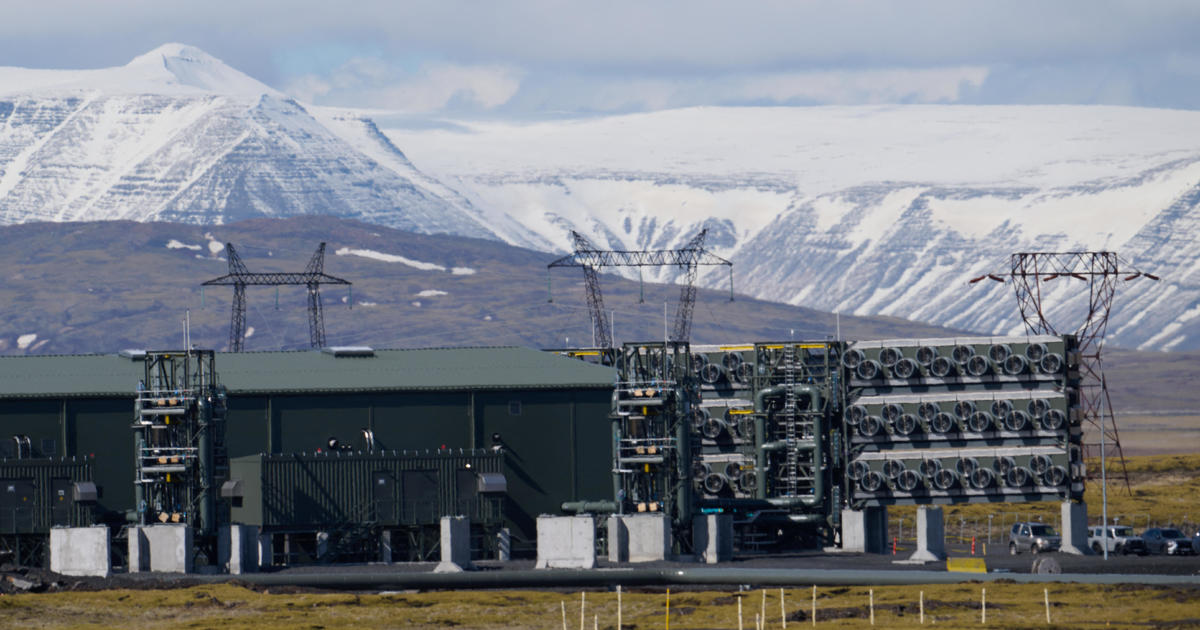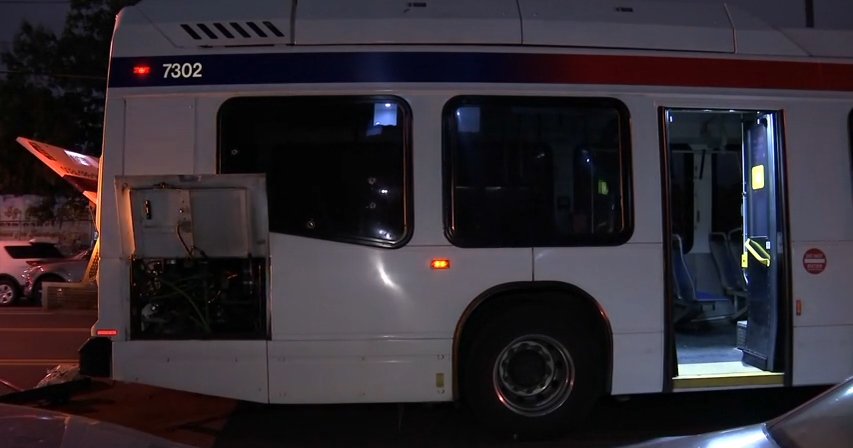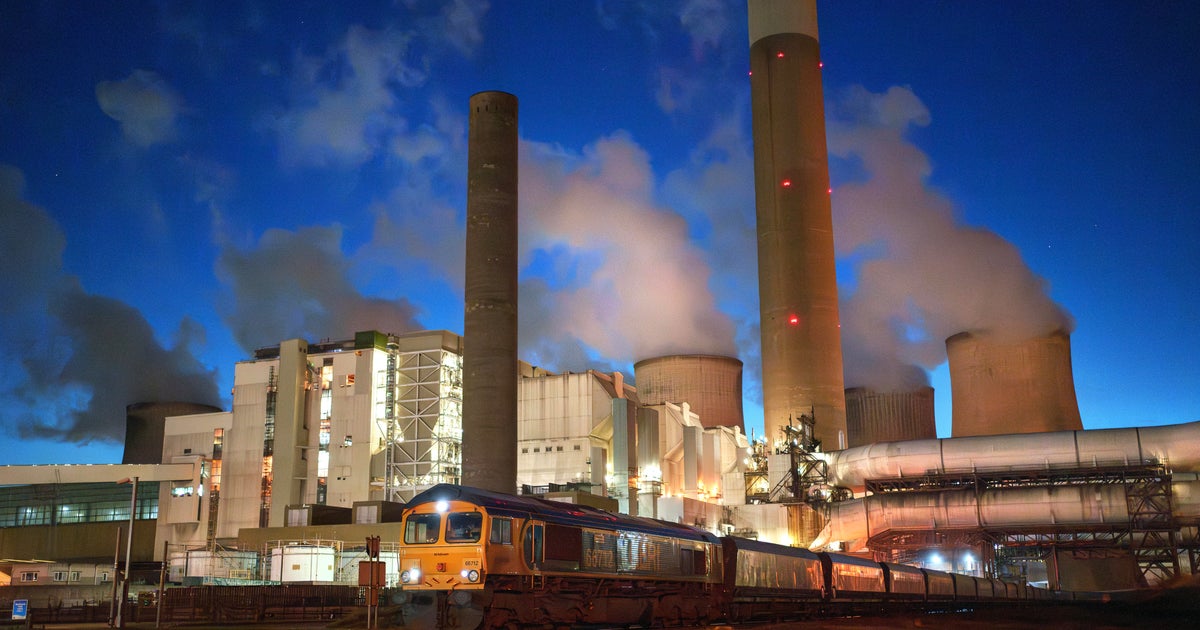CBS News
“Mammoth” carbon capture facility launches in Iceland, expanding one tool in the climate change arsenal

Hellisheidi, Iceland — With Mammoth’s 72 industrial fans, Swiss start-up Climeworks intends to suck almost 40,000 tons of CO2 from the air annually to bury underground, vying to prove the technology has a place in the fight against global warming. Mammoth, the largest carbon dioxide capture and storage facility of its kind, launched operations this week situated on a dormant volcano in Iceland.
The facility adds significant capacity to Climework’s first project, Orca, which also sucks the primary greenhouse gas that is fueling climate change out of the atmosphere.
How does Climeworks capture CO2?
Just 31 miles from an active volcano, the seemingly risky site was chosen for its proximity to the Hellisheidi geothermal energy plant necessary to power the facility’s fans and heat chemical filters to extract CO2 with water vapor.
HALLDOR KOLBEINS/AFP/Getty
The CO2 is then separated from the steam and compressed in a hangar where huge pipes crisscross.
Finally, the gas is dissolved in water and pumped underground with a “sort of giant SodaStream,” said Bergur Sigfusson, chief system development officer for Carbfix, which developed the process.
A well, drilled under a futuristic-looking dome, injects the water 2,300 feet down into the volcanic basalt that makes up 90% of Iceland’s subsoil, where it reacts with the magnesium, calcium and iron in the rock to form crystals — solid reservoirs of CO2.
There are a number of other CO2 capture technologies being put to use around the world, including in the U.S., where the Biden administration has committed nearly $4 billion to jumpstart the industry.
The methods range from warehouses full of stacked limestone blocks that absorb CO2 like sponges to burying compressed industrial and agricultural waste to lock the gas away for centuries.
Lofty carbon capture ambitions
For the world to achieve “carbon neutrality” by 2050, “we should be removing something like six to 16 billion tonnes [17.6 U.S. tons] of CO2 per year from the air,” said Jan Wurzbacher, co-founder and co-chief of Climeworks, at the inauguration of the first 12 container fans at Mammoth.
“I quite strongly believe that a large share of these… need to be covered by technical solutions,” he said.
“Not we alone, not as a single company. Others should do that as well,” he added, setting his start-up of 520 employees the goal of surpassing millions of tons by 2030 — and approaching a billion by 2050.
Speaking last year with CBS’ 60 Minutes, Climeworks’ chief technology officer Carolos Haertel said that technically the scaling up process can be done on a global scale — but he also said a single company can’t do it, and he hinted that political will must also be behind the initiatives.
60 Minutes
“Whether we are taking the right direction will depend as much on societal things than on technical matters,” Haertel told 60 Minutes’ Bill Whitaker at the Orca facility. “Am I optimistic as an engineer? I am, absolutely. Am I optimistic as a citizen? Maybe half-half. I haven’t made my mind up yet.”
Three years after opening Orca, Climeworks will increase its capacity from about 4,409 to 44,000 tons of CO2 captured annually once Mammoth is at full capacity — but that represents just seconds of the world’s actual emissions.
One of the companies interviewed by CBS News in 2023 about its plans to ramp up carbon capture operations said it hopes to eventually be locking away 50,000 tons of CO2 per year.
Only part of the solution to address emissions
According to the Intergovernmental Panel on Climate Change (IPCC), the United Nations’ climate expert body, carbon removal technologies will be necessary to meet the targets of the 2015 Paris Agreement, but major reductions of emissions are the priority.
The role of direct air capture with carbon storage (DACCS) remains minor in the various climate models due to its high price, and its deployment on a large scale depends on the availability of renewable energy to power it.
Climeworks is a pioneer, with the two first plants in the world to have surpassed the pilot stage at a cost of around $1,000 per ton captured. Wurzbacher expects that cost to decline to just $300 by 2030.
More than 20 new infrastructure projects, developed by various players and combining direct capture and storage, should be operational worldwide by 2030, with a combined capacity of around 11 million of tons.
“We need probably around $10 billion to proceed over the next decade to deploy our assets” in the United States, Canada, Norway, Oman and Kenya, said Christoph Gebald, Climeworks co-founder and co-chief. That’s 10 times what the company has already raised.
“When I’m standing now at Orca I think: ‘Oh this looks like a little bit like Lego bricks’. It’s a tiny thing compared to Mammoth,” Wurzbacher said.
Lego bought carbon credits generated by Climeworks for every ton of CO2 stored. The credits are a way of making the solution known to the general public, Gebald said, who has not ruled out selling credits to “big polluters” as well.
Critics of the technology point to the risk of giving them “license to pollute” or diverting billions of dollars that could be better invested in readily available technology such as renewable energy or electric vehicles.
CBS News
Former New York Gov. David Paterson, stepson attacked while walking in New York City

NEW YORK — Former New York Gov. David Paterson and his stepson were attacked in New York City on Friday night, authorities said.
The incident occurred just before 9 p.m. on Second Avenue near East 96th Street on the Upper East Side, according to the New York City Police Department.
Police said officers were sent to the scene after an assault was reported. When officers arrived, police say they found a 20-year-old man suffering from facial injuries and a 70-year-old man who had head pain. Both victims were taken to a local hospital in stable condition.
In a statement, a spokesperson for the former governor said the two were attacked while “taking a walk around the block near their home by some individuals that had a previous interaction with his stepson.”
The spokesperson said that they were injured “but were able to fight off their attackers.”
Both were taken to Cornell Hospital “as a precaution,” he added.
Police said no arrests have been made and the investigation is ongoing.
The 70-year-old Paterson, a Democrat, served as governor from 2008 to 2010, stepping into the post after the resignation of Eliot Spitzer following his prostitution scandal. He made history at the time as the state’s first-ever Black and legally blind governor.
CBS News
10/4: CBS Evening News – CBS News

Watch CBS News
Be the first to know
Get browser notifications for breaking news, live events, and exclusive reporting.
CBS News
Teen critically wounded in shooting on Philadelphia bus; one person in custody

A 17-year-old boy was critically injured and a person is in custody after a gunman opened fire on a SEPTA bus in North Philadelphia Friday evening, police said.
At around 6:15 p.m., Philadelphia police were notified about a shooting on a SEPTA bus traveling on Allegheny Avenue near 3rd and 4th streets in North Philadelphia, Inspector D F Pace told CBS News Philadelphia.
There were an estimated 30 people on the bus at the time of the shooting, Pace said, but only the 17-year-old boy was believed to have been shot. Investigators said they believe it was a targeted attack on the teenager and that he was shot in the back of the bus at close range.
According to Pace, the SEPTA bus driver alerted a control center about the shooting, which then relayed the message to Philadelphia police, who responded to the scene shortly.
Officers arrived at the scene and found at least one spent shell casing and blood on the bus, but no shooting victim, Pace said. Investigators later discovered the 17-year-old had been taken to Temple University Hospital where he is said to be in critical condition, according to police.
CBS Philadelphia
Through their preliminary investigation, police learned those involved in the SEPTA shooting may have fled in a silver-colored Kia.
Authorities then found a car matching the description of the Kia speeding in the area and a pursuit began, Pace said. Police got help from a PPD helicopter as they followed the Kia, which ended up crashing at 5th and Greenwood streets in East Mount Airy. Pace said the Kia crashed into a parked car.
The driver of the crashed car ran away but police were still able to take them into custody, Pace said.
Investigators believe there was a second person involved in the shooting who ran from the car before it crashed. Police said they believe this person escaped near Allegheny Avenue and 4th Street, leaving a coat behind.
According to Pace, police also found a gun and a group of spent shell casings believed to be involved in the shooting in the same area.
“It’s very possible that there may have been a shooting inside the bus and also shots fired from outside of the bus toward the bus,” Pace said, “We’re still trying to piece all that together at this time.”
This is an active investigation and police are reviewing surveillance footage from the SEPTA bus.










